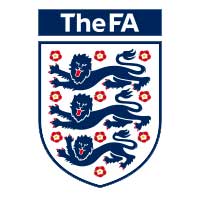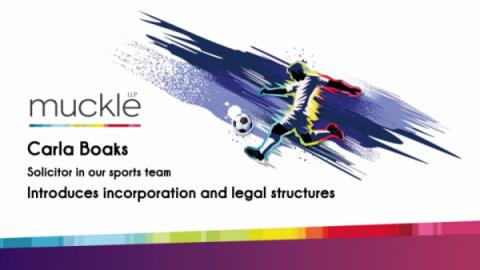
Related Downloads
FA Bitesize Guide introduction - Incorporation and legal structures
Carla Boaks, solicitor in our sports team, introduces our FA guide on incorporation and legal structures.
Watch VideoAll VideosTo help you decide the right legal structure for your club, we’ve put together this handy guide.
You should consider whether your club’s current legal structure is suitable, not only for now but for the future. The type of club that you want to be and your aspirations for the club, will help to determine what legal structure is most appropriate.
Legal structures at a glance
| Type | Incorporated? | Structure | Suitable for |
| Unincorporated association (UA) | No | A group of individuals typically governed by a management committee | Very small clubs with no assets |
| Company Limited by Guarantee (CLG) | Yes | Board of directors and legal members | Not-for-profit clubs where any money made is reinvested into the club |
| Company Limited by Shares (CLS) | Yes | Board of directors and shareholders | Clubs looking to distribute profit to its shareholders |
| Community Interest Company (CIC) | Yes | Board of directors and shareholders/legal members | Clubs wishing to operate as a social enterprise, reinvesting profit into the community whilst paying its directors |
| Charitable Incorporated Organisation (CIO) | Yes | Board of trustees and legal members | Clubs wishing to operate as a registered charity rather than a company |
Let’s explore each option in more detail…
Unincorporated Associations (UAs)
Most clubs start as UAs because this is the easiest, cheapest, and most informal way of setting one up. A UA has no separate legal identity from the people who run it. This means that:
- The committee members must personally enter into contracts (e.g. staffing, property and commercial contracts) for the club. So, if someone from the committee leaves then technically all the contracts will need updating, which could be an administrative nightmare.
- Any claim against the club will need to be brought against the committee members personally – typically the one(s) with the deepest pockets.
- The committee members may be personally liable for the debts or liabilities of the club. UAs are typically only suitable for small clubs without any assets, employees or significant contracts, and small clubs that don’t plan to have any of those in the future.
A UA is essentially a group of individuals bound together by the constitution or rules of their club. They are typically run/governed by a management committee.
UAs have little to no outside control (although, like all clubs, they do need to comply with relevant football regulations). Most grassroots/amateur clubs start in this form, so if you aren’t sure what your current legal structure is and you’re not registered at Companies House, chances are you are an unincorporated association. However, you should always seek legal advice to check.
Although insurance can help protect your committee members to an extent, you shouldn’t rely on it too much, as all insurance policies have exclusions and excesses, and not all risks can be insured against.
Incorporation is the key to shifting liability and risk away from your committee members, who, more often than not, are generously volunteering their time for the love of the sport. Liability and risk are likely to arise if your club is thinking about doing any of the following:
1. Acquiring property (e.g. entering into a lease).
2. Employing or otherwise engaging staff.
3. Entering into significant contracts (e.g. sponsorship deals or grant funding contracts (1).
If any of the above apply, it’s time to seriously consider incorporating. For more information, please see our Guide to Club Structures.
Company Limited by Guarantee (CLG)
This is a common and simple company legal structure. CLGs must comply with company law and are regulated by Companies House. A CLG must file annual accounts, a confirmation statement and directors’ details at Companies House.
The governing document of a CLG is its articles of association (which contain the key rules and regulations about how to run a company).
A CLG’s governance structure is comprised of two parts:
- Its board of directors.
The directors are ultimately responsible for the success (or otherwise) of the club and therefore set its strategy. They have certain duties and responsibilities that they must comply with under company law. - Its legal members.
(1) It is worth noting that it is increasingly the case that a club needs to be
incorporated as a condition of receiving third party funding.
As a rule of thumb, think of the legal members as the people you invite to your AGMs and who have a right to vote at those.
For some clubs, the directors and legal members are one and the same. For others, legal membership may include some, if not all, of the “members” who pay a fee to use your club’s facilities and/or to take part in its activities. The decision as to who should be a legal member is often a political one.
Note a CLG’s property will likely be subject to an “asset lock” which restricts where its assets can be transferred to should it wind up or cease to exist - the legal members typically cannot receive those assets.
A CLG can be set up at Companies House within one day.
Company Limited by Shares (CLS)
This is a common legal structure for clubs looking to make a profit and then distribute that profit to its shareholders each year rather than reinvest it all back into the club. So, this could be attractive if the club is looking for equity investors (e.g. where the club has a successful and ambitious first team). It would not be appropriate for clubs operating on a not-for-profit basis.
CLSs must comply with company law and are regulated by Companies House. A CLS must file annual accounts, a confirmation statement and directors’ details at Companies House.
The governing document of a CLS is its articles of association.
A CLS’ governance structure is similar to that of a CLG and is comprised of two parts:
1. Its board of directors.
2. Its shareholders.
The shareholders play a similar role to that of members in a CLG.
A CLS, unlike a CLG, does not typically have an “asset lock”.
A CLS can be set up at Companies House within one day.
Community Interest Company (CIC)
A CIC is either structured as a CLG or CLS with special additional features.
A CIC is typically suitable for a club that wants to operate as a social enterprise, conducting its activities for community benefit, and not purely for private advantage. The CIC model is designed to appeal to funding bodies and facilitate the financing of CICs through loans and (in the case of CICs set up as CLSs) share capital.
Certain grant funders might consider CIC registration to be beneficial when considering applications for project funding.
As in the case of a CLG/CLS, a CIC must comply with company law and is regulated by Companies House. A CIC must also comply with the CIC Regulations and is therefore also regulated by the CIC Regulator. There are additional filing requirements for a CIC.
The governing document of a CIC is its articles of association. A CIC’s governance structure is comprised of two parts:
1. Its board of directors.
2. Its members or shareholders.
CICs must satisfy a “community interest test” to make sure the CIC is established for community purposes. To satisfy the test, the CIC must demonstrate that its activities will be carried out for the benefit of the community.
A CIC’s property is subject to an “asset lock.” This ensures that the assets are used for the community’s benefit and that any asset transfer is restricted to another asset-locked body, such as a charity or another CIC.
Once registered as a CIC, it’s difficult to deregister. The CIC Regulator aims to process registration applications within 15 working days of receipt, typically.
Charitable Incorporated Organisation (CIO)
A CIO is an incorporated legal structure and also a registered charity. Being a charity is not a legal structure; it is a tax status. Please see our separate guide on "Special Tax Status" for further information.
A CIO tends to be popular among small to medium-sized clubs that want the benefit of being incorporated, and at the same time, consider that having the charity “badge” will support their fundraising efforts and help them to attract third-party grant funding.
A CIO must comply with charity law and is regulated by the Charity Commission.
The governing document of a CIO is its constitution.
A CIO’s governance structure is comprised of two parts:
1. Its board of trustees.
The trustees play a similar role to directors of a company. Trustees also have similar duties and responsibilities as directors of a company, although those are set out in charity law not company law.
2. Its legal members.
Where a club adopts the CIO foundation model constitution, its trustees and legal members are one and the same people. Where a club adopts the CIO association model constitution, its membership is broader.
The property of a CIO is subject to an “asset lock”. An application to set up a CIO can be processed in a few days to several months.
Speak to our team
To speak to a member of our friendly sports team, please contact us at [email protected] or on 0191 211 7799.
get in touch






